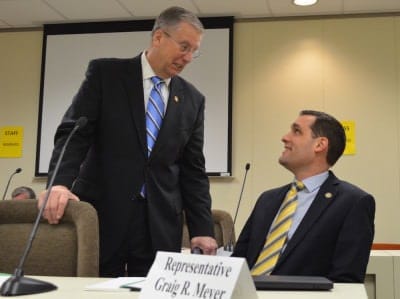

Editor’s Note: Graig Meyer is on a quest this session to find common ground among legislators for the benefit of our students. After a three-part series this week about his own quest for common ground, he is going to blog for EdNC about a bill with potential for common ground as it winds its way through the legislative process.
I believe that an A-to-F school grading system could help to improve North Carolina’s schools. I just don’t believe that system is the one we have now.
I was still working in schools when I heard about the legislation that led to this year’s School Performance Grades. Like most educators, I was appalled that politicians thought they could reduce the essence of a school to a simple letter grade. Heck, I don’t even like reducing the essence of a student’s learning to a single grade.
I believe that an A-to-F school grading system could help to improve North Carolina’s schools. I just don’t believe that system is the one we have now.
When the grades were released earlier this month, the results were – sadly – predictable. Among the schools in which 80 percent or more of students qualify for free and reduced price lunches, 81 percent received a D or F. Only one received an A. On the other end of the spectrum, more than 90 percent of schools in which fewer than 20 percent of the students qualify for free and reduced lunches received an A or B. Only one of those schools received an F.
North Carolina’s grading system has been widely criticized for being weighted heavily towards student proficiency (80 percent) over student growth (20 percent). Data analysis from Duke University’s Will Wilson showed that there is a 61 percent correlation between a school’s free and reduced price lunch population and its proficiency score, but only a 2 percent correlation between that same measure and its growth score. In other words, poor schools are predictably lower-achieving than rich schools, but you can’t make the same prediction for which school has the strongest student growth.
In a letter to the editor, Dr. Elliot Cramer, professor emeritus of the Department of Psychology at UNC, explained that the original methodology for 1990s-era North Carolina State Report Cards actually had a way to account for socioeconomic variations across schools. It’s hard to believe that 25 years later we failed to account for inputs and have a system that pits our richest and poorest schools against one another for the sake of comparison.
Another concern I have about these grades is that they are all stick and no carrot.
Another concern I have about these grades is that they are all stick and no carrot. Schools labeled with a failing grade have been given absolutely no direction or help to improve. I believe that most of these schools underperform more frequently for lack of support than for lack of capacity or hard work.
There is an assumption implicit in the School Performance Grades that when we tell people they’re not doing well, they will fix the problem. But if people knew how to fix the problem and had the resources to do so, they probably already would have fixed it.
I’m willing to set aside the debate about fully funding school improvement for another day. Without spending any additional money, it’s still possible to wonder, “What if our School Performance Grades were designed to act as an incentive for improvement rather than a punishment?”
If people knew how to fix the problem and had the resources to do so, they probably already would have fixed it.
In November 2014, when I attended the annual summit of the Foundation for Excellence in Education (former Florida Governor Jeb Bush’s school reform organization), I was one of the very few Democratic legislators in attendance. I was looking for ways in which to bridge the partisan divide in education reform. I found one when I heard officials from Florida talk about the way they use School Performance Grades.
On a panel with presenters from Florida and several other states, no one recommended using the 80/20 split that North Carolina uses. Of the states that use an A-to-F grading scale, the most common way to determine a school’s score is 50 percent performance and 50 percent growth. Many states even split the student growth score into 25 percent overall growth and 25 percent growth of the lowest-performing students.
Florida has experienced the some of most dramatic academic progress of any state over the last decade. Their education commissioner made the argument that their use of school grades has been the single most useful tool that they have for compelling schools to improve. She argued that no school wants to be graded D or F, and that their system makes it very clear what a school needs to improve in order to get a better grade.
Looking into Florida’s system, I realized that they use a larger set of data than we do in North Carolina, but all of it still falls into the categories of performance, growth, and growth of the lowest-performing students.
It’s rare to find an educational reform tool that doesn’t require much money, so let’s make this one work.
North Carolina could advance the use of school performance grades one step further by diversifying school grades to also measure progress on things that we know lead to strong educational results. It is difficult to mandate statewide education reforms, but using this mechanism would encourage schools to take their own initiative to improve. It would give them things to work towards and a proactive way to improve their grades.
Want schools to have more students taking advanced science and math classes? Include it in the grading formula. Want to prioritize closing racial achievement gaps? Give them a better grade for improving on that metric.
Like most professionals, educators want to succeed and are motivated by having goals for improvement. North Carolina’s school grading system should be more aspirational than punitive. It’s rare to find an educational reform tool that doesn’t require much money, so let’s make this one work. As a legislative initiative, we need education leaders in the General Assembly to work together to make School Performance Grades a robust tool for helping our schools develop a roadmap towards success.


